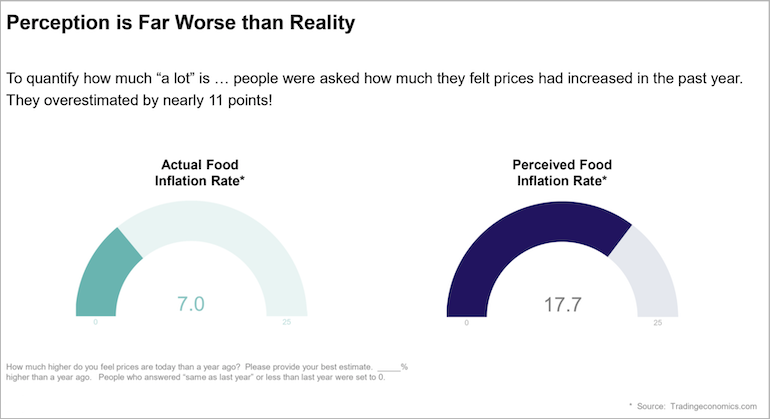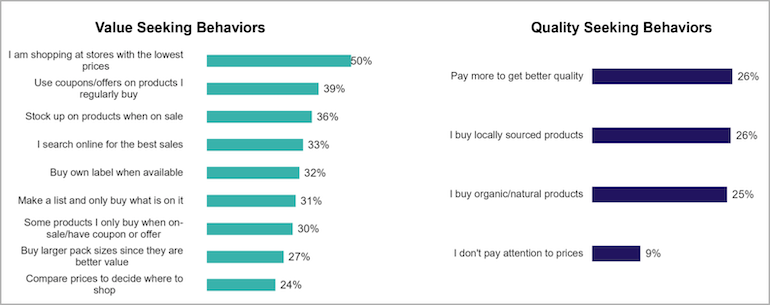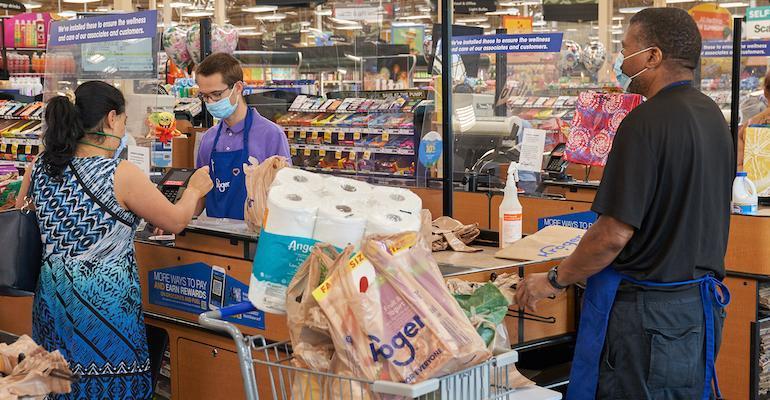Grocery costs, personal finances and the economy have surpassed COVID-19 as the top concerns of U.S. consumers, yet many shoppers deem food price inflation far above its actual rate, according to the latest dunnhumby Consumer Pulse Survey.
Poll respondents pegged food inflation at 17.7%, even though the U.S. Bureau of Labor Statistics reported the food-at-home Consumer Price Index at 7.4% for January, its latest reading, customer data science firm dunnhumby found in the ninth wave of its research, released Monday. Overall food inflation, including food-away-from home, stood at 7% in January.
What’s more, 83% of U.S. consumers surveyed think food prices have risen, and half said pricing has gone up a lot.

For the Consumer Pulse research, dunnhumby polled nearly 65,000 consumers in 23 countries in nine waves since March 29, 2020. Online surveys for the latest wave were conducted Jan. 25 to Feb. 8, 2022 — just past the peak of the Omicron COVID surge — and about 400 people were interviewed in each country. Shoppers in all nations studied overestimated the actual food inflation rate, by 14 points on average, dunnhumby noted.
“Americans’ belief that food prices are rising more than twice as fast as they actually are should concern retailers, manufacturers and the government alike,” Grant Steadman, president of dunnhumby’s Chicago-based North America unit, said in a statement. “We not only see this mismatch between sentiment and reality in the U.S., but also in every country we surveyed. Consumers are now more concerned with their finances and the country’s economy than they were five months ago. We need to revise our thinking about how consumers consider inflation.”
Value-seeking shoppers see food inflation rates at 18.4%, well above the 16.9% rate perceived by those not actively seeking value. Still, despite increased economic pressure over the last five months, the share of respondents employing value-seeking shopper strategies has held steady, at 53% in the ninth research wave versus 52% in the previous wave in September, dunnhumby noted.

The top value-seeking behaviors cited by U.S. consumers were shopping at stores with the lowest prices (named by 50% of respondents), using coupons/offers on regularly purchased products (39%) and stocking up on products when they’re on sale (36%). Other strategies include searching online for the best sales (cited by 33% of consumers), buying private labels when available (32%), purchasing larger pack sizes (27%) and comparing prices to determine where to shop (24%).
In terms of grocery retailers, Walmart was named as providing the best value for the money by 54% of shoppers polled, up 25 points from the September research and followed by Aldi (18%), Kroger (10%), and Amazon (10%).
Other chains cited for value included Target, Costco Wholesale, ShopRite, Sam’s Club, Publix, Safeway, Meijer, H-E-B, Save A Lot, Winn-Dixie, Food Lion, Stop & Shop and Trader Joe’s.
Fifty-one percent of U.S. shoppers expressed concern that, because of elevated food pricing, their money doesn’t go as far as it used to, up 10% from September 2021 and 12% from the third research wave in May 2020. Also, 60% said it seems like more products are out of stock, compared with 46% last September.

Most consumers (58%) believe the U.S. economy is weak, a three-point uptick from September 2021 and the same percentage as in the seventh research wave in February 2021, dunnhumby reported. Similarly, 40% of consumers see their own finances as weak, consistent with the September and February waves of the study in 2021.
“Likely, we have not yet seen the full extent of how consumers will react to food price increases,” according to Steadman. “This could diverge further, particularly if the security situation in Europe worsens and further impacts energy and commodity prices globally.”
Meanwhile, Americans’ concern about COVID-19 is at an all-time low, the dunnhumby Worry Index showed. Thirteen percent of Americans said they were worried about the pandemic through early February, down from 17% in September 2021, 23% in February 2021, a peak of 32% in November 2020 and 31% in March 2020, when the virus was declared a national emergency. The index measures “worry” as extreme concern about the virus and not feeling safe when shopping.
The surge in COVID cases from the Omicron variant shaved the number of trips consumers made to stores in late January through early February (5.7 versus 6.0 in September) and reversed their belief that things were starting to return to normal, dunnhumby pointed out. Just 19% of respondents said things were returning to normal in stores through early February versus 24% in September.
Likewise, 39% of U.S. consumers indicated they were satisfied with the in-store shopping experience, down 3% from September. Thirty-six percent felt stores were doing a good job with COVID, well above their approval rate for how government has dealt with the pandemic (22%).





